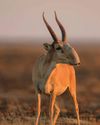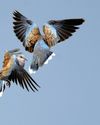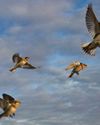
But curiously, not all species are affected. One, in particular, is the tree bumblebee, which has recently taken up residence in the UK. Scientists are now getting to the bottom of how this bumblebee has not only claimed new ground – but is thriving.
“The tree bumblebee is one of these amazing species that, in the face of other bumblebee declines, is expanding massively in range,” says Ryan Brock, from the University of East Anglia, who is studying the UK population.
Tree bumblebees were first recorded in the UK in 2001, when a lone individual was found on a bramble flower on the outskirts of the New Forest. Native to continental Europe and Asia, their abundance had steadily increased through the 20th century in nearby countries such as Belgium and Germany. To experts, the bee’s appearance in the UK was intriguing, but foreseeable.
However, what no one could have predicted is the astonishing success of tree bumblebees once they reached the UK. Spreading at an average rate of roughly 11,500km2 per year, they rapidly colonised England and Wales. They had buzzed north to Scotland by 2013 and winged over to Ireland by 2017. Now, tree bumblebees are one of the UK’s commonest and most widespread species.
この記事は BBC Wildlife の June 2021 版に掲載されています。
7 日間の Magzter GOLD 無料トライアルを開始して、何千もの厳選されたプレミアム ストーリー、9,000 以上の雑誌や新聞にアクセスしてください。
すでに購読者です ? サインイン
この記事は BBC Wildlife の June 2021 版に掲載されています。
7 日間の Magzter GOLD 無料トライアルを開始して、何千もの厳選されたプレミアム ストーリー、9,000 以上の雑誌や新聞にアクセスしてください。
すでに購読者です? サインイン

SNAP-CHAT
Justin Gilligan on giant spider crabs and holding hands with an octopus

STEPPE CHANGE
Herds of saiga have returned to Kazakhstan, but there's a fine balance to tread

TREES FOR LIFE
Community is at the heart of conservation in the tropical forests of southern Belize

WHEN DOVES CRY
Turtle doves are now the UK's fastest declining bird species, but the RSPB is on a mission to save them

SURVIVAL OF THE CUTEST
We can't help being drawn to cute creatures, but our aesthetic preferences both help and hinder conservation

LIGHT ON THE NORTH
Spectacular images of Arctic foxes, reindeer and musk oxen reveal the wild beauty and diversity of Scandinavia

ROLLING IN THE DEEP
The super-sized crustacean that lives in the deepest, darkest ocean

LET'S GET TOGETHER
Clay licks deep in the Amazon explode in a riot of colour, with macaws the stars of the show

FEMALE OF THE SPECIES
To sponge or not to sponge? That is the question for the bottlenose dolphins (Tursiops aduncus) living in Shark Bay, Western Australia.

7 nature encounters for the month ahead
WITH NATURALIST AND AUTHOR BEN HOARE